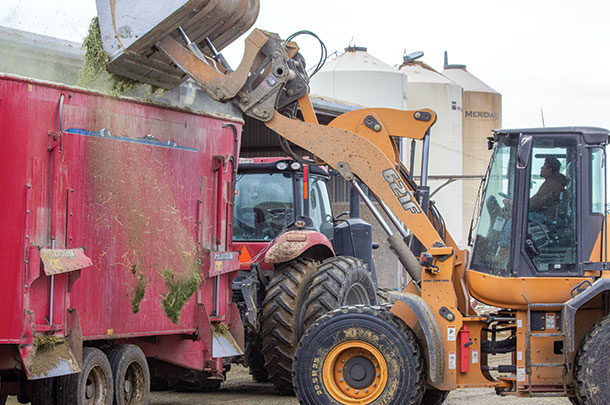Operating motorized equipment is an essential part of your farming operation and is often required for day-to-day tasks, but it is important to remember any type of motorized equipment comes with significant potential hazards. These hazards vary depending on the equipment being used and the work environment. Examples of hazards likely to be present when operating equipment include the risk of collision with pedestrians, other equipment or other objects, as well as the risk of injury from moving parts. Types of equipment used in your workplace may include tractors, skid steers and forklifts, as well as many other types of motorized equipment.
Pre-use inspection
All equipment must be inspected before each use. The operator must review each component of the equipment to ensure there is no damage or wear that will affect operation. Check the fluid levels and lubrication, tire pressure, operating controls and overall condition of the equipment. Make sure safety devices and guards are in place, and lights, horns and other components of the equipment are working. The best way to complete a pre-use inspection is to use a simple checklist; this helps to make sure you cover all components that need to be inspected, and the document provides proof the inspection was completed. Inspection checklists may be available from the equipment manufacturers.
Report any defect to your supervisor and do not use any equipment that is damaged or defective. If equipment is damaged, you must remove the key and clearly mark the equipment as out-of-service and ensure repairs are made before the next use.
Distractions
It can be easy to get distracted or try to multitask when you are spending a lot of time operating equipment or when you are in a rush to get multiple things done. We understand how tempting it may be to check your phone or just send a quick text, but these short distractions can have serious consequences. Multitasking may be required throughout your day, but it can be very dangerous when working around equipment and when operating equipment. It is important to give your full attention to the task at hand while working, especially when equipment is involved.
Pedestrian safety
Safety is the responsibility of both pedestrians and equipment operators. Each of us is responsible for each other, whether we are on foot or on a vehicle, indoors or outdoors.
Equipment operators must always be aware of their surroundings and must always be watching for pedestrians. It is important for pedestrians to remember there is always a possibility of a driver not seeing them or momentarily losing focus. Even a driver who always sounds their horn at intersections may have their mind elsewhere one time. Therefore, pedestrians must always be aware of where the equipment is and where it may be going. Pedestrians must consider safety when working indoors as well as outdoors if equipment is operating in the area. Ensure you follow these safety precautions when walking in an area where equipment may be operating:
- Look both ways before walking into an area where operators may not see you.
- Never cross in front or behind equipment without communicating or making eye contact with the operator. Even if the equipment is stopped, you must assume it could move at any time.
- Consider the extra space equipment will need to brake because of the weight and design. Always allow for this braking space when walking around lift trucks and other equipment.
- Lift trucks and some other equipment have a rear-end swing. This means that when the operator turns, the back end swings out. Make sure you stay away from the back and sides of lift trucks.
- Never stand under any raised part of equipment or raised load.
- Do not stand in an area where material is being loaded or unloaded, as items may be knocked over or fall.
Pedestrians must also consider the driving conditions and other factors that may affect the operator’s ability to see you. Some things to think about include the level of noise in the area, lighting, blind spots in the equipment or restricted visibility because of the load being carried.
The best way to avoid a collision with a pedestrian is to keep pedestrians away from operating equipment. Pedestrians should stay out of operating areas unless they are specifically required to be there.
Safe equipment operation
Below are 10 safety precautions to be followed when operating motorized equipment. By following these tips, we aim to ensure the safety of the equipment operator as well as others in the work area.
- All operators must receive training for the specific equipment being used; this training must include a hands-on component as well as an evaluation of the operator’s competency before they are allowed to operate the equipment on their own.
- Read and follow all safety decals and safety instructions located on the equipment, and only use equipment for its intended purpose.
- Ensure you always have clear visibility of the area around you. Look in the direction of travel and use a spotter when necessary.
- Keep bystanders and other equipment out of the equipment operating area whenever possible. Do not allow pedestrians to work or walk near equipment being operated.
- Wear your seatbelt if the equipment has one, and do not disable or remove any safety devices such as guards or automatic shut-offs and audible alarms.
- Ensure equipment is maintained in good condition and do not modify equipment unless you have assessed the modifications to ensure the equipment can still be safely operated.
- Drive to suit your load and conditions. Adjust your speed, avoid slippery or uneven ground, keep loads low, and be aware of the dimension of the equipment and load.
- Only use attachments or implements appropriate for the equipment, and ensure they are properly hitched and secured with primary and secondary securement devices.
- Use three-point contact when getting on and off equipment, and ensure the equipment and your footwear are clear of ice and snow or other slip and trip hazards.
- When you are done, park on even ground, disengage the PTO if being used, lower any attachments to the ground, apply the parking brake, turn off the engine and remove the keys.









